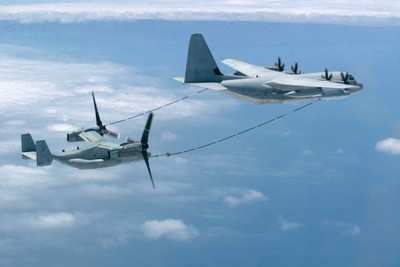Low On Gas? Nearest Pump Just Ahead... At 8,000 Feet
When running on empty, a driver pulls into a station, pays,
selects a fuel type, inserts the nozzle into the vehicle and fills
their tank.

A Marine Corps pilot, on the other hand, radios to another
aircraft for support, and ascends 8,000 feet into the clouds at
speeds of 200 knots to hook up to an 85-foot tube, trailing from
either wing of a supporting aircraft. The aircraft gases up and
pilots maneuver it back into the fight as rapidly as possible.
From the first in-air refueling attempts in 1921 -- a man
walking wing-to-wing from a JN-4 Jenny, wearing a gas tank on his
back -- to the effectiveness in the lengthened Vietnam War
search-and-rescue flights, aerial refueling has prolonged flight
duration and allowed combat aircraft to increase their range.
Recently, the MV-22 Ospreys -- currently exclusive to the 2nd
Marine Aircraft Wing out of Marine Corps Air Station New River, NC
-- flew more than 2,100 nautical miles to conduct various training
exercises with the squadrons of the 3rd Marine Aircraft Wing at
MCAS Miramar.
3rd MAW’s squadron, Marine Aerial Refueler Transport
Squadron 352, known as the "Raiders," teamed up with 2nd
MAW’s Marine Medium Tiltrotor Squadron 162, nicknamed the
“Golden Eagles”, at extreme altitudes to participate in
aerial refueling missions August 22 and 24.
During the training, one of the Raider's aircraft, a KC-130J
Hercules, delivered more than 10,000 pounds of fuel to two of the
Golden Eagle's Ospreys.
"The purpose and importance of aerial refueling is to allow the
aircrew to continue deeper into the fight," said Maj. Brent A.
Johnson, the mission commander for the training exercise.
During the arial refueling, the KC-130J releases a fuel hose
from each wing. A basket, known as a drogue, attached to the end of
each hose connects with the probe of the Osprey. The tubes deliver
fuel from the tank of the Hercules to the Osprey.
To allow for a smooth connection, the Osprey flies in a basic
formation with the Hercules. The MV-22 pilot keeps his eyes on the
KC-130J while watching the basket in his peripheral vision until he
maneuvers the probe into the refueling hose.
The crew chief and loadmaster in the back of the massive, flying
gas station, act as aerial observers, ensuring the receiving
aircraft maintains the proper pre-contact position. They also make
certain the receiver does not tear the hose and cause a fuel
leakage.
"Communications between the pilots and the observers is
essential because the pilots have no way of seeing what's going on
in the back of the plane," said Cpl. Christopher Chamberlain, a
loadmaster with VMGR-352. "We let them know if something goes wrong
or if a component isn't functioning properly."
Both aircraft's pilots coordinate their speeds, to allow proper
connection for the refueling process, explained Capt. Rodney
Rodriguez, the KC-130J pilot for the exercise.

"The hook-up and delivery needs to occur as quickly as
possible," said Rodriguez. "The longer it takes to make a
connection, the more fuel we burn and the less we have to give
them."
As ANN reported, MV-22
Ospreys will make their debut in combat this fall. Integration
training between the East and West Coast units will better prepare
the Marines for the team efforts in Iraq, explained 1st Lt. Craig
Anderson, a pilot with VMM-162.
(Aero-News salutes Lance Cpl. Jessica N. Aranda, MCAS
Miramar)
 ANN's Daily Aero-Linx (04.13.24)
ANN's Daily Aero-Linx (04.13.24) ANN's Daily Aero-Term (04.13.24): Beyond Visual Line Of Sight (BVLOS)
ANN's Daily Aero-Term (04.13.24): Beyond Visual Line Of Sight (BVLOS) Airborne 04.09.24: SnF24!, Piper-DeltaHawk!, Fisher Update, Junkers
Airborne 04.09.24: SnF24!, Piper-DeltaHawk!, Fisher Update, Junkers Aero-News: Quote of the Day (04.14.24)
Aero-News: Quote of the Day (04.14.24) ANN's Daily Aero-Term (04.14.24): Maximum Authorized Altitude
ANN's Daily Aero-Term (04.14.24): Maximum Authorized Altitude




